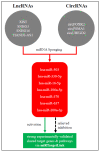Spotlight on Exosomal Non-Coding RNAs in Breast Cancer: An In Silico Analysis to Identify Potential lncRNA/circRNA-miRNA-Target Axis
- PMID: 35955480
- PMCID: PMC9369058
- DOI: 10.3390/ijms23158351
Spotlight on Exosomal Non-Coding RNAs in Breast Cancer: An In Silico Analysis to Identify Potential lncRNA/circRNA-miRNA-Target Axis
Abstract
Breast cancer (BC) has recently become the most common cancer type worldwide, with metastatic disease being the main reason for disease mortality. This has brought about strategies for early detection, especially the utilization of minimally invasive biomarkers found in various bodily fluids. Exosomes have been proposed as novel extracellular vesicles, readily detectable in bodily fluids, secreted from BC-cells or BC-tumor microenvironment cells, and capable of conferring cellular signals over long distances via various cargo molecules. This cargo is composed of different biomolecules, among which are the novel non-coding genome products, such as microRNAs (miRNAs), long non-coding RNAs (lncRNAs), and the recently discovered circular RNA (circRNA), all of which were found to be implicated in BC pathology. In this review, the diverse roles of the ncRNA cargo of BC-derived exosomes will be discussed, shedding light on their primarily oncogenic and additionally tumor suppressor roles at different levels of BC tumor progression, and drug sensitivity/resistance, along with presenting their diagnostic, prognostic, and predictive biomarker potential. Finally, benefiting from the miRNA sponging mechanism of action of lncRNAs and circRNAs, we established an experimentally validated breast cancer exosomal non-coding RNAs-regulated target gene axis from already published exosomal ncRNAs in BC. The resulting genes, pathways, gene ontology (GO) terms, and Kyoto Encyclopedia of Genes and Genomes (KEGG) analysis could be a starting point to better understand BC and may pave the way for the development of novel diagnostic and prognostic biomarkers and therapeutics.
Keywords: biomarkers; breast cancer; circular RNAs; exosomes; long non-coding RNA; microRNAs; non-coding RNA.
Conflict of interest statement
The authors declare no conflict of interest.
Figures







Similar articles
-
Insights on the Biomarker Potential of Exosomal Non-Coding RNAs in Colorectal Cancer: An In Silico Characterization of Related Exosomal lncRNA/circRNA-miRNA-Target Axis.Cells. 2023 Apr 4;12(7):1081. doi: 10.3390/cells12071081. Cells. 2023. PMID: 37048155 Free PMC article. Review.
-
Exosomal noncoding RNA (ncRNA) in breast cancer pathogenesis and therapy; two sides of the same coin.Exp Cell Res. 2025 Jan 1;444(1):114359. doi: 10.1016/j.yexcr.2024.114359. Epub 2024 Nov 26. Exp Cell Res. 2025. PMID: 39608481 Review.
-
In silico analysis and comprehensive review of circular-RNA regulatory roles in breast diseases; a step-toward non-coding RNA precision.Pathol Res Pract. 2024 Nov;263:155651. doi: 10.1016/j.prp.2024.155651. Epub 2024 Oct 19. Pathol Res Pract. 2024. PMID: 39454476 Review.
-
CircRNA, lncRNA, and mRNA profiles of umbilical cord blood exosomes from preterm newborns showing bronchopulmonary dysplasia.Eur J Pediatr. 2022 Sep;181(9):3345-3365. doi: 10.1007/s00431-022-04544-2. Epub 2022 Jul 5. Eur J Pediatr. 2022. PMID: 35790551 Free PMC article.
-
The significance of exosomal non-coding RNAs (ncRNAs) in the metastasis of colorectal cancer and development of therapy resistance.Gene. 2025 Feb 10;937:149141. doi: 10.1016/j.gene.2024.149141. Epub 2024 Dec 4. Gene. 2025. PMID: 39643147 Review.
Cited by
-
A Comprehensive Bioinformatic Analysis Identifies a Tumor Suppressor Landscape of the MEG3 lncRNA in Breast Cancer.Indian J Surg Oncol. 2024 Dec;15(4):752-761. doi: 10.1007/s13193-024-01992-0. Epub 2024 Jun 27. Indian J Surg Oncol. 2024. PMID: 39555361
-
Exosomal ncRNAs in reproductive cancers†.Biol Reprod. 2025 Feb 14;112(2):225-244. doi: 10.1093/biolre/ioae170. Biol Reprod. 2025. PMID: 39561105 Free PMC article. Review.
-
Non-coding RNA: A key regulator in the Glutathione-GPX4 pathway of ferroptosis.Noncoding RNA Res. 2024 May 20;9(4):1222-1234. doi: 10.1016/j.ncrna.2024.05.007. eCollection 2024 Dec. Noncoding RNA Res. 2024. PMID: 39036600 Free PMC article. Review.
-
LncRNA microarray profiling identifies novel circulating lncRNAs in hidradenitis suppurativa.Mol Med Rep. 2024 Jul;30(1):112. doi: 10.3892/mmr.2024.13236. Epub 2024 May 17. Mol Med Rep. 2024. PMID: 38757342 Free PMC article.
-
Breast Cancer Chemoresistance: Insights into the Regulatory Role of lncRNA.Int J Mol Sci. 2023 Nov 2;24(21):15897. doi: 10.3390/ijms242115897. Int J Mol Sci. 2023. PMID: 37958880 Free PMC article. Review.
References
Publication types
MeSH terms
Substances
Grants and funding
LinkOut - more resources
Full Text Sources
Medical

